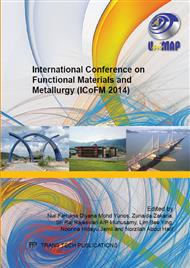p.399
p.405
p.411
p.417
p.423
p.429
p.437
p.443
p.449
Characterization of Hematite Nanoparticles (Fe2O3) Produced by High Energy Milling for Dye Removal Catalyst
Abstract:
Hematite nanoparticles with average particle size of 75.6 and 93.4 nm were produced by mechanical grinding technique using planetary ball mill. The ground hematite were characterized by X-ray diffraction analysis technique, specific surface area analysis (BET), transmission microscope (TEM) and scanning electron microscope (SEM). The effects of different properties of hematite particles used as a catalyst for decolorization of synthetic dye, Remazol Red 3B (RR3B) were investigated. The experimental results show that smaller particle size of 75.6 nm decolourized at the rate of 95.8% within 10 min reaction while larger particle size of 93.4 nm decolorized at the rate of 95.9% within 60 min reaction. The decolorization of RR3B dye by both catalyst were achieved with minimum iron leached (<5 mgL-1) which fulfill the Malaysian Environmental Quality (Industrial Effluent) Regulations 2009. The continuous mode for decolorization of RR3B was carried out and complete decolorization was achieved with low iron dissolution which demonstrates the possibilities of using milled hematite as catalyst for large-scale textile industry wastewater treatment applications.
Info:
Periodical:
Pages:
423-428
Citation:
Online since:
June 2015
Authors:
Keywords:
Price:
Сopyright:
© 2015 Trans Tech Publications Ltd. All Rights Reserved
Share:
Citation:


